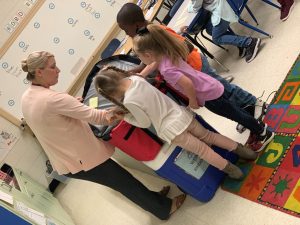Planning and Dedication Prove Successful in Feeding Hoke County Students
Hoke County School District
Raeford, North Carolina
 Deborah Davis Carpenter, Child Nutrition Executive Director with Hoke County Schools in Raeford, NC, has spent many years devising ways to feed more of her 8,700 Hoke County students school breakfast. Her motivation for bringing an alternative breakfast model to her schools is to decrease hunger and nurse visits for head and stomach aches, as well as to improve overall health and increase performance in the classroom for all students.
Deborah Davis Carpenter, Child Nutrition Executive Director with Hoke County Schools in Raeford, NC, has spent many years devising ways to feed more of her 8,700 Hoke County students school breakfast. Her motivation for bringing an alternative breakfast model to her schools is to decrease hunger and nurse visits for head and stomach aches, as well as to improve overall health and increase performance in the classroom for all students.
Carpenter grew up hearing from her mother, “If you start your day with breakfast, you start it well by nourishing your body and your brain!” With those words inspiring her, Carpenter put her planning into action. She visited nearby school districts, such as Bladen County and Guilford County, to see their alternative breakfast models. She also attended North Carolina’s No Kid Hungry Child Hunger Leaders Conference where she was able to hear testimonies of other school districts that made the alternative breakfast model work. She began to read, investigate and study the benefits of Breakfast in the Classroom and other alternative models. Having always been an advocate for healthy nutrition for students, Carpenter did everything possible to bring an alternative breakfast program to Hoke County Schools.
Carpenter created a presentation for the Hoke County Schools superintendent, school board members, administrators, and leadership team. Upon gaining approval and support from leadership to implement the alternative breakfast program for the 2018-2019 school year, Carpenter admits she did not know where she would get funding. That’s where Action for Healthy Kids’ school breakfast grants, made possible by the Kellogg Company Fund, came through.
With the help of her colleagues in the Child Nutrition Department, Carpenter submitted applications and received $25,000 in grant funding for 13 schools in Hoke County.
Hoke County Schools Child Nutrition purchased the equipment necessary to put the alternative breakfast program into action, including kiosk mobile carts, rolling coolers, insulated bags, and other equipment needed to make breakfast more accessible for their students. The alternative models now in place include Breakfast in the Classroom for kindergarten through 8th grade, Grab-and-Go Breakfast for students in grades 6 to 12, and Second Chance Breakfast for students in grades 9 to 12 at the high school.
Breakfast participation has increased, going from 48% in October 2017 to 97% in October 2018. In addition, school staff are hearing positive feedback from parents, students are visiting the nurse less frequently, and there is a greater sense of community in the classroom.
Debra Dowles, Assistant Superintendent, agrees that having an alternative breakfast model starts everyone’s morning right, saying, “Breakfast in the Classroom creates a smooth start to our students’ day of learning because they do not feel as rushed eating in the classroom as they do eating in the cafeteria with the traditional service. Students know they do not have to choose between eating breakfast and being a part of instruction—they can do both.”
As for Carpenter, she believes this breakfast success ties directly to her motto: “Children must be healthy to learn, and they must learn to be healthy.”